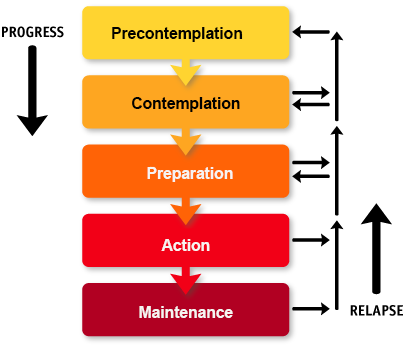4.3 Behaviour Change
Change is often challenging and awkward because it requires wading into unfamiliar territory, modifying old habits, redefining comfort zones, and embracing uncertainty. As Robin Sharma writes in The 5 A.M. Club, “All change is hard at first, messy in the middle, and gorgeous at the end,” emphasizing that the initial stages of transformation can be daunting but ultimately lead to a rewarding outcome. (Sharma, 2018).
This process is typically accompanied by some form of sacrifice (e.g., giving up late-night snacking, excessive screen time, or unhealthy coping mechanisms in exchange for healthier, more sustainable choices that are more likely to foster optimal well-being). If you are someone who has been living recklessly or constantly seeking self-gratification, making the necessary changes will not instantly make things easier. In fact, it might feel even harder at first, similar to an alcoholic experiencing withdrawal symptoms.
Understanding the stages and staying committed throughout helps make the process more manageable and, ultimately, more successful.
Transtheoretical Model of Behaviour Change
The Transtheoretical Model of Behaviour Change (TTM), developed by James Prochaska and Carlo DiClemente in the late 1970s, offers a comprehensive framework for understanding how individuals initiate and sustain meaningful behavioural changes. It is extensively employed in health psychology for interventions such as smoking cessation, substance abuse treatment, and wellness-related initiatives (Prochaska & DiClemente, 1982).
Origins

Prochaska and DiClemente drew upon key concepts from multiple psychological theories, including Behaviourism, Social Cognitive Theory, and Psychoanalysis, to create a model that depicts how individuals move through distinct stages when altering behaviours. The TTM emphasizes that change is not a single event but rather a process, often involving progress, setbacks, and cyclical patterns.
Usefulness
The TTM helps practitioners and individuals tailor strategies to a person’s current stage of readiness. Instead of a “one size fits all” approach, it encourages specific, stage-appropriate interventions. Recognizing which stage someone is in can inform how best to encourage and maintain new behaviours. For instance, strategies that work for someone in the “Preparation” stage differ significantly from those suited for someone in “Maintenance.”
One of the model’s most valuable insights is the recognition that people move fluidly through these stages. An individual may progress from Contemplation to Preparation, then circle back to Contemplation if new challenges arise, or even return to Precontemplation under the right circumstances. This cyclical nature highlights the dynamic and sometimes non-linear journey of behaviour change.
Stages of the TTM
Precontemplation
Definition: The individual is not yet acknowledging that there is a problem behaviour that needs to change or is unaware that the behaviour could be harmful.
Characteristics: Lack of awareness, denial, or minimal interest in change. They might believe, “I don’t have a problem” or “It’s not that big of a deal.”
Key Tasks: Increase awareness of risks and consequences, address misinformation, and encourage reflection on how current behaviours align with personal values.
Contemplation
Definition: The individual acknowledges the problem and starts thinking about making a change, but has not committed yet.
Characteristics: Mixed feelings, ambivalence, and weighing pros and cons. “I know I should probably change, but I’m not sure I’m ready.”
Key Tasks: Encourage self-exploration, highlight the benefits of change, and reduce fears or uncertainties that might be preventing commitment.
Preparation
Definition: The individual is planning to take action soon and may begin making small changes.
Characteristics: Setting a specific date to start, gathering resources, or telling friends about the intent to change. “I’m going to start my new diet next Monday.”
Key Tasks: Develop a clear plan, identify support systems, and set realistic goals that align with personal values or motivations.
Action
Definition: The individual actively modifies their behaviour to create positive change.
Characteristics: Implementing strategies, seeking social support, and facing challenges as they arise. “I’ve started following a meal plan and exercising regularly.” This typically last approximately 6 months.
Key Tasks: Provide reinforcement, track progress, and maintain motivation. Celebrate milestones and learn from setbacks.
Maintenance
Definition: After achieving initial goals, the person works to sustain the new behaviours and prevent relapse.
Characteristics: Ongoing commitment, adjusting strategies as needed, and integrating the change into daily life. “I’ve made healthy eating and regular workouts part of my routine.”
Key Tasks: Identify potential triggers for relapse, continue reinforcing positive habits, and stay vigilant for signs of old patterns returning.
Relapse & The Upward Spiral Effect
Relapse, or returning to old behaviours, is a common and often challenging part of the change process, leading to feelings of guilt, frustration, or shame. It can happen at any stage and is considered a normal aspect of transformation. Instead of viewing relapse as failure, it helps to see it as an opportunity to learn from setbacks, revisit what led to the slip, and refine strategies for preventing future recurrences. To quote motivational speaker and author Dennis Waitley, “failure is fertilizer.”
In the TTM, each cycle of progress and relapse ultimately supports forward momentum. Rather than landing back at the starting line, you carry with you new insights and a sharper understanding of what does and does not work. Research looking at individuals trying to quit drinking shows it commonly takes more than eight attempts before someone successfully stops for good. Each “failed” attempt is a crucial stepping stone, teaching lessons that increase the likelihood of long-term success. This concept, sometimes referred to as the “upward spiral,” highlights that even when setbacks happen, they can be harnessed to strengthen one’s overall journey toward lasting behaviour change.

